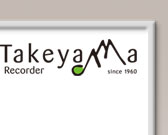Greetings from Takeyama Recorder Workshop - I am Hiroyuki Takeyama.
Making recorders is basically all about working with wood. I have been involved in recorder production for over 35 years. I would like to write a few notes on my ideas as a craftsman working with wood, and also about things I would like you to know.
Takeyama Recorder Workshop used to manufacture bobbins for spinning machines in the early days. It may be hard to conceive of their relation to recorders, but from a wood craftsperson’s point of view, they are both “narrow, long wood products with rotational symmetry, with a bore hole.” Actually, a traditional Japanese technique with lathe is utilised for the manufacture of this kind of products. In the past, “wood-pipe” seems to have just referred to “turned wood products in general” rather than “woodwind instruments” in the industry.
We used to make our own edged tools for making bobbins at our workshop. This skill helped us in developing the reamers and special turning tools essential for recorder making.
One of the vital techniques in making recorders is “voicing”. There are no textbook methods for this. You just have to learn it yourself by trial and error, seeking opinions of experienced craftsmen, copying old instruments and so on, until you establish your own way of doing it.
Even though the design of the instruments are the same, depending on the characteristic of the material, setting of the block, etc., there are different ways of voicing for each of them. The recorder is played and adjusted by listening to the tone repeatedly. Sometimes it takes days until it reaches the tone quality that I am happy with.
The aim of voicing is to create the optimum condition for each recorder to produce tone, therefore, each and every one of the finished recorders will be unique. As a maker, I cannot tell which recorder has “good” or “bad” tone. They are all like my children, that I have brought up with care. On choosing my instrument, I would like you to play and check out the tone. And I hope that you would look after the instrument, so that it is always maintained in top condition.
For a craftsman, the finished “product” tells everything, so I am not used to talking about the difficulty of the work or to going on about the ingenuity. I plucked up courage to write these notes because by writing about production, I wanted you to know that a traditional Japanese technique is utilised in making an instrument from Europe, the recorder. What requires great care in the manufacturing process also requires great care in maintenance. Hence, I thought it might help you to keep the instrument in good condition if you know about the manufacturing process.
To end, I would like to thank people from various fields who gave me support in writing this column.
|











